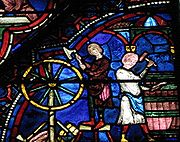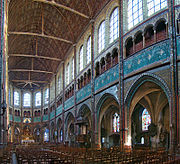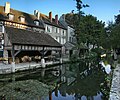This is an old revision of this page, as edited by Gadget850 (talk | contribs) at 12:21, 27 December 2014 (update gallery center, replaced: <center><gallery> → <gallery class="center">, </gallery></center> → </gallery> using AWB). The present address (URL) is a permanent link to this revision, which may differ significantly from the current revision.
Revision as of 12:21, 27 December 2014 by Gadget850 (talk | contribs) (update gallery center, replaced: <center><gallery> → <gallery class="center">, </gallery></center> → </gallery> using AWB)(diff) ← Previous revision | Latest revision (diff) | Newer revision → (diff) This article is about the city in France. For the settlement in the Falkland Islands, see Chartres, Falkland Islands. For the ferry, see MV Chartres. For the cathedral, see Chartres Cathedral.| This article needs additional citations for verification. Please help improve this article by adding citations to reliable sources. Unsourced material may be challenged and removed. Find sources: "Chartres" – news · newspapers · books · scholar · JSTOR (February 2014) (Learn how and when to remove this message) |
Place in Centre-Val de Loire, France
| Chartres | |
|---|---|
 | |
 Coat of arms Coat of arms | |
| Location of Chartres | |
| Country | France |
| Region | Centre-Val de Loire |
| Department | Eure-et-Loir |
| Arrondissement | Chartres |
| Intercommunality | Chartres Métropole |
| Government | |
| • Mayor (2008–2014) | Jean-Pierre Gorges |
| Area | 16.85 km (6.51 sq mi) |
| Population | 39,273 |
| • Density | 2,300/km (6,000/sq mi) |
| Time zone | UTC+01:00 (CET) |
| • Summer (DST) | UTC+02:00 (CEST) |
| INSEE/Postal code | 28085 /28000 |
| Elevation | 121–161 m (397–528 ft) (avg. 142 m or 466 ft) |
| French Land Register data, which excludes lakes, ponds, glaciers > 1 km (0.386 sq mi or 247 acres) and river estuaries. | |
Chartres (Template:IPA-fr) is a commune and capital of the Eure-et-Loir department in France. It is located 96 km (60 mi) southwest of Paris. This city is well known for its cathedral.
History
Chartres was one of the principal towns of the Carnutes, and by the Romans was called Autricum, from the river Autura (Eure), and afterwards civitas Carnutum. The name "Chartres" derives from "Carnutes". It was burned by the Normans in 858, and unsuccessfully besieged by them in 911.
During the Middle Ages it was the chief town of Beauce, and gave its name to a countship which was held by the counts of Blois and Champagne and afterwards by the house of Châtillon, a member of which in 1286 sold it to the crown. It was raised to the rank of a duchy in 1528 by Francis I. After the time of Louis XIV the title of duke of Chartres was hereditary in the family of Orléans.
In 1417 it fell into the hands of the English, from whom it was recovered in 1432. It became seat of a Duchy in 1528. During the Wars of Religion, it was attacked unsuccessfully by the Protestants in 1568, and was taken in 1591 by Henry IV, who was crowned there three years afterwards.
In the Franco-Prussian War it was seized by the Germans on 2 October 1870, and continued during the rest of the Campaign to be an important centre of operations.
The city suffered heavy damage by bombing in the course of World War II, but the Cathedral of Chartres was spared by an American Army officer who challenged the order to destroy it.
Colonel Welborn Barton Griffith, Jr. questioned the strategy of destroying the cathedral and volunteered to go behind enemy lines to find out whether the German Army was occupying the cathedral and using it as an observation post. With a single enlisted soldier to assist, Col. Griffith proceeded to the cathedral and confirmed the Germans were not using it. After he returned from his reconnaissance, he reported that the cathedral was clear of enemy troops. The order to destroy the cathedral was withdrawn and the Allies later liberated the area. Col. Griffith was killed in action on 16 August 1944 in the town of Leves, near Chartres.
Following deep reconnaissance missions in the region by the 3rd Cavalry Group and units of the 1139 Engineer Combat Group, and after heavy fighting in and around the city, Chartres was liberated, on 18 August 1944, by the U.S. 5th Infantry and the 7th Armored Divisions belonging to the XX Corps of the 3rd US Army commanded by General George S. Patton.
Population
| Year | Pop. | ±% |
|---|---|---|
| 1793 | 15,000 | — |
| 1800 | 13,794 | −8.0% |
| 1806 | 13,809 | +0.1% |
| 1821 | 13,714 | −0.7% |
| 1831 | 14,439 | +5.3% |
| 1836 | 14,750 | +2.2% |
| 1841 | 16,383 | +11.1% |
| 1846 | 17,353 | +5.9% |
| 1851 | 18,234 | +5.1% |
| 1856 | 18,925 | +3.8% |
| 1861 | 19,531 | +3.2% |
| 1866 | 19,442 | −0.5% |
| 1872 | 19,580 | +0.7% |
| 1876 | 20,468 | +4.5% |
| 1881 | 21,080 | +3.0% |
| 1886 | 21,903 | +3.9% |
| 1891 | 23,108 | +5.5% |
| 1896 | 23,182 | +0.3% |
| 1901 | 23,431 | +1.1% |
| 1906 | 23,219 | −0.9% |
| 1911 | 24,103 | +3.8% |
| 1921 | 23,349 | −3.1% |
| 1926 | 24,630 | +5.5% |
| 1931 | 25,357 | +3.0% |
| 1936 | 27,077 | +6.8% |
| 1946 | 26,422 | −2.4% |
| 1954 | 28,740 | +8.8% |
| 1962 | 31,495 | +9.6% |
| 1968 | 34,469 | +9.4% |
| 1975 | 38,928 | +12.9% |
| 1982 | 37,119 | −4.6% |
| 1990 | 39,595 | +6.7% |
| 1999 | 40,361 | +1.9% |
| 2008 | 39,159 | −3.0% |
| 2011 | 39,273 | +0.3% |
Geography
Chartres is built on a hill on the left bank of the Eure River. Its renowned medieval cathedral is at the top of the hill, and its two spires are visible from miles away across the flat surrounding lands. To the south-east stretches the fruitful plain of Beauce, the "granary of France", of which the town is the commercial centre.
Main sights
Cathedrals and churches




The town is best known for the Cathedral of Chartres (French: Cathédrale Notre-Dame de Chartres), widely considered to be the finest Gothic cathedral in France. Its historical and cultural importance is recognized by its inclusion on the UNESCO list of World Heritage Sites. Its construction started in 1205, following the destruction of the old cathedral of Chartres. Construction took 66 years.
The abbey church of St.Pierre, dating chiefly from the 13th century, contains, besides some fine stained glass, twelve representations of the apostles in enamel, created about 1547 by Léonard Limosin. Of the other churches of Chartres also noteworthy are St Aignan (13th, 16th and 17th centuries) and St Martin-au-Val (12th century).
The surrounding city financed the stained glass windows. It is not known how the blue color of the glass was created, so it has been impossible to replicate.
Museums
- Musée des Beaux-Arts, fine arts museum (located near the Cathedral of Chartres) housed in the former episcopal palace.
- Le Grenier de l'Histoire Musée, history museum specializing in military uniforms and accoutrements.
- Le Centre International du Vitrail, a workshop-museum and cultural center devoted to stained glass art.
- Muséum de sciences naturelles et de la préhistoire, Natural Science and Prehistory Museum
- Conservatoire du Machinisme et des Pratiques Agricoles, an agricultural museum
Other sights
The Eure River, which at this point divides into three branches, is crossed by several bridges, some of them ancient, and is fringed in places by remains of the old fortifications, of which the Porte Guillaume (14th century), a gateway flanked by towers, is the most complete specimen. The steep, narrow streets of the old town contrast with the wide, shady boulevards which encircle it and divide it from the suburbs. The Cbs St Jean, a pleasant park, lies to the north-west, and squares and open spaces are numerous.
The hotel de ville, a building of the 17th century, containing a museum and library, an older hotel de ville of the 13th century, and several medieval and Renaissance houses, are of interest. There is a statue of General F. S. Marceau-Desgraviers (b. 1769), a native of the town.
- La Maison Picassiette, a house decorated inside and out with mosaics of chards of broken china and pottery
Economy
Chartres is one of the most important market towns in the region of Beauce (known as "the granary of France").
The game pies and other delicacies of Chartres are well known, and the industries also include flour-milling, brewing, distilling, iron-founding, leather manufacture, perfumes, dyeing, and the manufacture of electronic equipment, car accessories, stained glass, billiard requisites and hosiery.
Since 1976 fashion and perfumes company Puig has a production plant in this commune.
Transport
The Gare de Chartres railway station offers frequent services to Paris, and a few daily connections to Le Mans, Nogent-le-Rotrou and Courtalain. The A11 motorway connects Chartres with Paris and Le Mans.
Sport
Chartres is home to two semi-professional association football clubs; FC Chartres, who play in the French sixth division, and HB Chartres, who play in the seventh tier.
Chartres has a table tennis club which is playing in the Pro A (French First division) and in the European Champions League. The club won the ETTU Cup on the season 2010 – 2011 and it finished at the second position in the French First division.
Chartres has the second most important squash club in France.
There is also a handball club and it is playing in the French second division.
In November 2012, Chartres organized the European Short Course Swimming Championships.
Diocese
Main article: Diocese of ChartresThe town is the seat of a bishop, a prefecture, and a court of assizes. It has tribunals of first instance and of commerce, a chamber of commerce, training colleges, a high school for boys, a communal college for girls, and a branch of the Bank of France.
Pilgrimages
Chartres has been a site of Christian pilgrimage since the Middle Ages. The poet Charles Péguy (1873–1914) revived the pilgrimage route between Paris and Chartres before the First World War. After the war, some students carried on the pilgrimage in his memory. Since the 1980s, the association Notre-Dame de Chrétienté <http://www.nd-chretiente.com>, with offices in Versailles, has organized the annual 100 km (62 mi) pilgrimage on foot from the cathedral of Notre-Dame de Paris to the cathedral of Notre-Dame de Chartres. About 15,000 pilgrims, mostly young families from all over France, participate every year.
Bishops
Notable bishops of Chartres:
- Fulbert of Chartres (1007–1029)
- St. Ivo of Chartres (1090–1115)
- John of Salisbury (1176–1180)
- Erard de la Marck (1472–1538)
Personalities
Chartres was the birthplace of:
- Fulcher of Chartres (born around 1059 in or near Chartres), chronicler of the First Crusade
- Philippe Desportes (1546–1606), poet
- Mathurin Régnier (1573–1613), satirist
- André Félibien (1619–1695), architect and historiographer
- Pierre Nicole (1625–1695), Jansenist theologian
- Philippe de Dangeau (1638–1720), officer and member of the Académie française
- Antoine François Desrues (1744–1777), poisoner
- Jacques Pierre Brissot (1754–1793), a leading member of the Girondist movement (French Revolution)
- Jérôme Pétion de Villeneuve (1756–1794), writer and politician
- François Séverin Marceau-Desgraviers (1769–1796), general
- Achille Guénée (1809–1880), lawyer and entomologist
- Pierre-Jules Hetzel (1814–1886), editor and publisher
- Jacqueline de Romilly (born 1913), philologist
- Nicolas Escudé (born 1976), professional tennis player
- Julien Escudé (born 1979), professional footballer for Sevilla FC and the France national football team
- Loïc Duval (born 12 June 1982), professional racingdriver; currently A1 Team France, Formula Nippon and Super GT
- Julien Cetout footballer
- Laura Kamdop, handball player
- Allison Pineau handball player
- Eric Lada footballer
International relations
See also: List of twin towns and sister cities in FranceTwin towns – Sister cities
Chartres is twinned with:
 Ravenna in Italy (since 1957)
Ravenna in Italy (since 1957) Speyer in Germany (since 1959)
Speyer in Germany (since 1959) Chichester in the United Kingdom (since 1959)
Chichester in the United Kingdom (since 1959) Bethlehem in Palestinian Authority (since 1995)
Bethlehem in Palestinian Authority (since 1995) Évora in Portugal (since 2003)
Évora in Portugal (since 2003) Cusco in Peru (since 1989)
Cusco in Peru (since 1989) Sakurai, Nara in Japan (since 1989)
Sakurai, Nara in Japan (since 1989)
Gallery
-
 Chartres railway station
Chartres railway station
-
 17th-Century engraving of Chartres "skyline"
17th-Century engraving of Chartres "skyline"
-
 The Cathedral of Chartres
The Cathedral of Chartres
-
 The Apostles and Saint Sculptures of Chartres
The Apostles and Saint Sculptures of Chartres
-
 The Old Town – River Eure
The Old Town – River Eure
-
 Half-timbered house in the Old Town
Half-timbered house in the Old Town
-
 Hill of St. François
Hill of St. François
-
 View south from the Cathedral
View south from the Cathedral
-
 On the banks of the Eure River
On the banks of the Eure River
See also
Chartres' city website Chartres' tourism office website Chartres' archeology service
References
- INSEE
 This article incorporates text from a publication now in the public domain: Chisholm, Hugh, ed. (1911). Encyclopædia Britannica (11th ed.). Cambridge University Press.
This article incorporates text from a publication now in the public domain: Chisholm, Hugh, ed. (1911). Encyclopædia Britannica (11th ed.). Cambridge University Press. {{cite encyclopedia}}: Missing or empty|title=(help)- Chartres and the Chartres Cathedral – Visitor Guide
- La Maison Picassiette in Chartres
- ^ MilitaryTimes.com. "MilitaryTimes Hall of Valor". Welborn Barton Griffith, Jr. Military Times, a Gannett Company. Retrieved 10 May 2011. Note: The Distinguished Service Cross was awarded posthumously for saving the cathedral.
- Jay Nordlinger (2011). "A Colonel at Chartres". The Corner. NationalReview.com. Retrieved 11 May 2011.
- Winieska, Françoise, August 1944, The Liberation of Rambouillet, France, SHARY, 1999, pp. 19–23, ISBN 2-9514047-0-0
- "To be multinational in Spain costs a lot, because the domestic market is too small". La Vanguardia. Retrieved 9 May 2012.
- "British towns twinned with French towns [via WaybackMachine.com]". Archant Community Media Ltd. Archived from the original on 5 July 2013. Retrieved 20 July 2013.
- "Twinning with Palestine". 1998–2008 The Britain – Palestine Twinning Network. Retrieved 29 November 2008.
- "::Bethlehem Municipality::". bethlehem-city.org. Retrieved 10 October 2009.
- "Ciudades Hermanas (Sister Cities)" (in Spanish). Municipalidad del Cusco. Retrieved 23 September 2009.
External links
- Tourist office website
- City council website (in French)
- Chartres' archeology service website (in French)
- Website about archaeological excavations (in French)
- Visiting Chartres (English)
- Photo of the abbey church of St.Pierre
- Music recorded in Chartres Cathedral in the resonant space of the labyrinth
- Chartres World Heritage Site in panographies – 360 degree interactive imaging
| Communes of the Eure-et-Loir department of France | |
|---|---|
| |